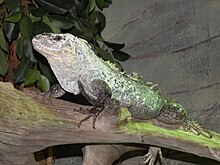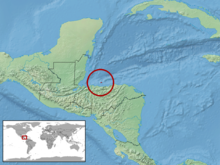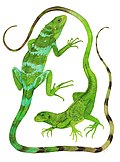Ctenosaura bakeri
| Ctenosaura bakeri | |
|---|---|

| |
| Scientific classification | |
| Domain: | Eukaryota |
| Kingdom: | Animalia |
| Phylum: | Chordata |
| Class: | Reptilia |
| Order: | Squamata |
| Suborder: | Iguania |
| Family: | Iguanidae |
| Genus: | Ctenosaura |
| Species: | C. bakeri
|
| Binomial name | |
| Ctenosaura bakeri Stejneger, 1901
| |

| |
| Synonyms[3] | |
Ctenosaura bakeri, also known as the Utila spiny-tailed iguana, Baker's spinytail iguana, swamper or wishiwilly del suampo, is a
The Utila iguana is the only
Males may grow up to 76 centimeters (30 in) in length, while females are smaller, with a length of up to 56 centimeters (22 in). Eggs are laid in sandy beaches and hatch about 60–76 days later, with the hatchlings returning to live in the mangrove forests.Brought to the brink of extinction by the 1990s due to hunting, it was brought back to international attention by German herpetologist Dr. Gunther Köhler and his book Reptiles of Central America.[7] Although several zoos and wildlife associations have instituted programs for the iguanas on Utila, the species still finds itself threatened due to overhunting and may face more of a threat in the form of habitat loss.[1] Extreme conservation efforts are in place to try to prevent this species from going extinct.[8]
Taxonomy
Ctenosaura bakeri was first described by Norwegian-born American zoologist Leonhard Stejneger in 1901, while working for the Smithsonian Institution.[9] The generic name, Ctenosaura, is derived from two Greek words: ctenos (Κτενός), meaning "comb" (referring to the comblike spines on the lizard's back and tail), and saura (σαύρα), meaning "lizard".[8] Its specific name, bakeri, is the Latinized form of Stejneger's friend and colleague Frank Baker, who was a former director of the National Zoo in Washington, D.C.[7]
The
Distribution and habitat

Endemic to
Description
The Utila iguana has a grey-brown to black coloring when young, the only species of spiny-tail iguana with such a dark color when young. Other members of the genus have a green or yellow coloring when young and turn darker with age. As this animal matures it can be a blue or light gray in color, depending on heat conditions or even the animal's temper.[4][8]
Males achieve a maximum total length (including tail) of 76 centimeters (30 in), while females are typically 30% smaller at 56 centimeters (22 in) total length. Males have a small dewlap and a dorsal crest made up of 56 large dorsal spines, making the animal sexually dimorphic.[8] This dorsal crest consists of white and black spines arranged in alternating groups of two or three of the same color.[4]
Diet
Like most iguanids, Ctenosaura bakeri is primarily
Reproduction
Adults make their homes within holes in various mangrove trees and maintain an
The hatchlings are 15 centimeters (5.9 in) long, the body length being a mere 3 centimeters (1.2 in) with the tail accounting for 12 centimeters (4.7 in) of its total length.[5] The hatchlings' dark skin color enables them to blend in with the dark floor of the mangrove forests to help elude predators.[4]
Conservation status
Gunther Köhler found the species at the brink of extinction, perhaps even functionally extinct in the wild as of 1994 due to overhunting and its restricted habitat.
This species currently has an estimated wild population of 10,000 animals in 2–3 subpopulations, but is greatly threatened by
In 2004, as a result of Köhler's expedition and subsequent book, Reptiles of Central America, the Conservation Project of the Utila Iguana (CPUI) was founded.[7] The International Iguana Society and the CPUI have sought to purchase land to preserve habitats for the iguanas and plan to establish an outpost staffed by Iguana Research and Breeding station personnel, who will aid in monitoring the property and work with developers to select building sites that preserve as much undisturbed beach area as possible.[11]
The Iguana Research and Breeding station employs a "head-starting" program for newly hatched iguanas. "Head-starting", originally used to protect hatching
Zoological institutions
The Utila iguana is maintained in a number of zoos throughout Europe, as well as two in the United States (
According to the
| Institution | Male(s) | Female(s) | Unknown | Born in the last year |
|---|---|---|---|---|
| Barcelona Zoo | 0 | 0 | 2 | 0 |
| Blackpool Zoo | 1 | 1 | 0 | 0 |
| Cotswold Wildlife Park | 0 | 0 | 1 | 0 |
| Chester Zoo | 1 | 1 | 0 | 0 |
| Zoo d'Amnéville | 1 | 0 | 0 | 0 |
Durrell Wildlife Park |
1 | 2 | 3 | 0 |
| London Zoo | 1 | 1 | 3 | 3 |
| Paignton Zoo | 0 | 0 | 1 | 0 |
Plock Zoo |
1 | 0 | 2 | 4 |
Rotterdam Zoo |
2 | 3 | 0 | 0 |
| Museum of Natural History of Tournai | 1 | 0 | 0 | 0 |
| Whipsnade Zoo | 1 | 2 | 13 | 13 |
| European Subtotal | 10 | 10 | 24 | 20 |
| Fort Worth Zoo | 4 | 1 | 2 | 0 |
| Fresno Chaffee Zoo | 0 | 1 | 2 | 0 |
| US Subtotal | 4 | 2 | 4 | 0 |
| Totals | 14 | 12 | 28 | 20 |
References
- ^ . Retrieved 13 November 2021.
- ^ "Appendices | CITES". cites.org. Retrieved 2022-01-14.
- ^ "Ctenosaura bakeri ". The Reptile Database. www.reptile-database.org.
- ^ a b c d e f Gutsche, Alexander (2005). "Distribution and Habitat Utilization of Ctenosaura bakeri on Utila". Iguana. 12 (3): 143.
- ^ a b c d e Gutsche A, Köhler G (2004). "A fertile hybrid between Ctenosaura similis (GRAY 1831) and C. bakeri STEJNEGER 1901 (Squamata: Iguanidae) on Isla de Utila, Honduras". Salamandra. 40 (3/4): 201–206.
- ^ a b Dirksen L, Gutsche A (2006). "Beobachtungen zur Saurophagie bei Ctenosaura bakeri (Squamata: Iguanidae)". Elaphe. 14 (3): 51–52.
- ^ London Telegraph. Retrieved 2008-09-07.
- ^ a b c d e f g Malfatti, Mark (2007). "A Look at the Genus Ctenosaura: Meet the World's fastest lizard and its kin". Reptiles Magazine. 15 (11): 64–73.
- .
- ^ Schulte U (2007). "Beobachtungen zur Hybridisierung zwischen Ctenosaura similis (GRAY 1831) und Ctenosaura bakeri STEJNEGER 1901 auf Utila, Honduras". Elaphe. 15 (1): 55–59.
- ^ a b Binns, John (2003). "Taxon Reports Ctenosaura bakeri ". Iguana Specialist Group Newsletter. 6 (1). San Diego, California: Zoological Society of San Diego. Archived from the original on May 9, 2008. Retrieved 2008-09-04.
- ^ a b Burgess, Rachel; Fiallos, Maria (2003-03-31). "Utila For Sale: Where will the Iguanas Go?". Honduras This Week. Archived from the original on June 21, 2008. Retrieved 2008-09-04.
- ISBN 0-520-23854-0.
- International Species Information System. 2008-08-21. Retrieved 2008-09-05.
Further reading
- ISBN 3-936180-02-4.
External links
- Iguana Research and Breeding Station
- Fort Worth Zoo Museum of Living Art – Species List: Utila Island iguana
- Hope hatches for critically endangered lizard on the brink of extinction
- Profile on West Coast Iguana


